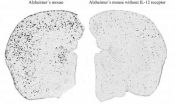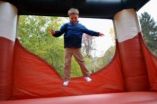(Press-News.org) Alzheimer's disease is one of the most common causes of dementia. In Germany and Switzerland alone, around 1.5 million people are affected, and forecasts predict a doubling of the number of patients worldwide within the next 20 years. The accumulation of particular abnormal proteins, including amyloid-ß (Aβ) among others, in patients' brains plays a central role in this disease. Prof. Frank Heppner from the Department of Neuropathology at Charité and his colleague Prof. Burkhard Becher from the Institute for Experimental Immunology at the University of Zurich were able to show that turning off particular cytokines (immune system signal transmitters) reduced the Alzheimer's typical amyloid-ß deposits in mice with the disease. As a result, the strongest effects were demonstrated after reducing amyloid-ß by approximately 65 percent, when the immune molecule p40 was affected, which is a component of the cytokines interleukin (IL)-12 and -23.
Relevant for human therapy
Follow-up experiments also relevant for humans showed that substantial improvements in behavioral testing resulted when mice were given the antibody blocking the immune molecule p40. This effect was also achieved when the mice were already showing symptoms of the disease. Based on the current study by Prof. Heppner's and Prof. Becher's team, the level of p40 molecules is higher in Alzheimer's patients' brain fluid, which is in agreement with a recently published study by American colleagues demonstrating increased p40 levels in blood plasma of subjects with Alzheimer's disease, thus showing obvious relevance for human therapy.
The significance of the immune system in Alzheimer's research is the focus of current efforts. Prof. Heppner and Prof. Becher suspect that cytokines IL-12 and IL-23 themselves are not causative in the pathology, and that the mechanism of the immune molecule p40 in Alzheimer's requires additional clarification. However, they are convinced that the results of their six-years of research work justify the step toward clinical studies in humans, for which they plan to collaborate with a suitable industrial partner.
IIn the context of other illnesses, such as psoriasis, a medication that suppresses p40 in humans has already been applied. "Based on the safety data in patients," comment Profs. Heppner and Becher, "clinical studies could now be implemented without delay. Now, the goal is to bring the new therapeutic approach to Alzheimer patients quickly."
INFORMATION:
Literature:
Johannes vom Berg, Stefan Prokop, Kelly R. Miller, Juliane Obst, Roland E. Kälin, Ileana Lopategui-Cabezas, Anja Wegner, Florian Mair, Carola G. Schipke, Oliver Peters, York Winter, Burkhard Becher, and Frank L. Heppner. Inhibition of IL-12/IL-23 signaling reduces Alzheimer's disease-like pathology and cognitive decline. Nature Medicine. November 25, 2012. doi: 10.1038/nm.2965
Alzheimer's disease in mice alleviated promising therapeutic approach for humans
2012-11-26
ELSE PRESS RELEASES FROM THIS DATE:
Patient's own immune cells may blunt viral therapy for brain cancer
2012-11-26
COLUMBUS, Ohio – Doctors now use cancer-killing viruses to treat some patients with lethal, fast-growing brain tumors. Clinical trials show that these therapeutic viruses are safe but less effective than expected.
A new study led by researchers at the Ohio State University Comprehensive Cancer Center – Arthur G. James Cancer Hospital and Richard J. Solove Research Institute (OSUCCC – James) shows that the reason for this is in part due to the patient's own immune system, which quickly works to eliminate the anticancer virus.
The findings, published in the journal Nature ...
Temple-Penn researchers identify calcium 'accelerator' to keep cell power supply going
2012-11-26
(Philadelphia, PA) – A team of scientists from Temple University School of Medicine and the University of Pennsylvania has moved another step closer to solving a decades-long mystery of how the all-important flow of calcium into the cell's power source, the mitochondria, is controlled.
By painstakingly shutting down the activity of 50 genes, one at a time, they have identified a protein, MCUR1, which hugs the inside of the mitochondrial membrane and is part of an elaborate mitochondrial channel pore system. MCUR1 acts as an accelerator to help regulate calcium coming ...
Exercise rate related to improvements in Parkinson’s disease
2012-11-26
CHICAGO – People with Parkinson's disease benefit from exercise programs on stationary bicycles, with the greatest effect for those who pedal faster, according to a study presented today at the annual meeting of the Radiological Society of North America (RSNA). Functional connectivity magnetic resonance imaging (fcMRI) data showed that faster pedaling led to greater connectivity in brain areas associated with motor ability.
Parkinson's disease is a chronic, progressive disorder of the central nervous system. Early-stage symptoms like shaking and difficulty with walking ...
Too much or too little activity bad for knees
2012-11-26
CHICAGO – Both very high and very low levels of physical activity can accelerate the degeneration of knee cartilage in middle-aged adults, according to a new study presented at the annual meeting of the Radiological Society of North America (RSNA).
Nearly one in every two people in the U.S. may develop knee osteoarthritis by age 85, according to the Centers for Disease Control and Prevention. By 2030, an estimated 67 million Americans over the age of 18 are projected to have physician-diagnosed arthritis.
Researchers at the University of California in San Francisco ...
Active lifestyle boosts brain structure and slows Alzheimer’s disease
2012-11-26
CHICAGO – An active lifestyle helps preserve gray matter in the brains of older adults and could reduce the burden of dementia and Alzheimer's disease (AD), according to a study presented today at the annual meeting of the Radiological Society of North America (RSNA).
Dementia exacts a staggering toll on society. More than 35 million people worldwide are living with the disease, according to the World Health Organization, and the prevalence is expected to double by 2030. AD is the most common cause of dementia and currently has no cure.
Cyrus Raji, M.D., Ph.D., radiology ...
Imaging shows some brains compensate after traumatic injury
2012-11-26
CHICAGO – Using a special magnetic resonance imaging (MRI) technique to image patients with mild traumatic brain injury (MTBI), researchers have identified a biomarker that may predict which patients will do well over the long term, according to a study presented today at the annual meeting of the Radiological Society of North America (RSNA).
The results of the study showed that in some patients the brain may have changed to compensate for the damage caused by the injury.
"This finding has huge potential implications for preventing and repairing the damage that accompanies ...
Researchers discover gender-based differences in Alzheimer's disease
2012-11-26
CHICAGO – All patients with Alzheimer's disease (AD) lose brain cells, which leads to a shrinking, or atrophy, of the brain. But the pattern of gray matter loss is significantly different in men and women, according to a study presented today at the annual meeting of the Radiological Society of North America (RSNA).
"We found that the extent and distribution of regional gray matter volume loss in the brain was strongly influenced by gender," said lead researcher Maria Vittoria Spampinato, M.D., associate professor of radiology at the Medical University of South Carolina ...
Study finds alarming 15-fold increase in inflatable bouncer-related injuries among children
2012-11-26
VIDEO:
Inflatable bouncers such as bounce houses, slides or obstacle courses are the new craze for kids' birthday parties and/or celebrations. While they appear to be a fun activity for a...
Click here for more information.
A new study by researchers at the Center for Injury Research and Policy of The Research Institute at Nationwide Children's Hospital examined pediatric injuries associated with inflatable bouncers, such as bounce houses and moonwalks. Researchers found ...
Researchers find evidence that brain compensates after traumatic injury
2012-11-26
November 26, 2012 – (BRONX, NY) – Researchers at Albert Einstein College of Medicine of Yeshiva University and Montefiore Medical Center have found that a special magnetic resonance imaging (MRI) technique may be able to predict which patients who have experienced concussions will improve. The results, which were presented today at the annual meeting of the Radiological Society of North America (RSNA), suggest that, in some patients, the brain may change to compensate for the damage caused by the injury.
"This finding could lead to strategies for preventing and repairing ...
Modeling the breaking points of metallic glasses
2012-11-26
Metallic glass alloys (or liquid metals) are three times stronger than the best industrial steel, but can be molded into complex shapes with the same ease as plastic. These materials are highly resistant to scratching, denting, shattering and corrosion. So far, they have been used in a variety of products from golf clubs to aircraft components. And, some smartphone manufacturers are even looking to cast their next-generation phone cases out of it.
But despite their potential, the mechanical properties of these substances are still a scientific mystery. One lingering question ...


